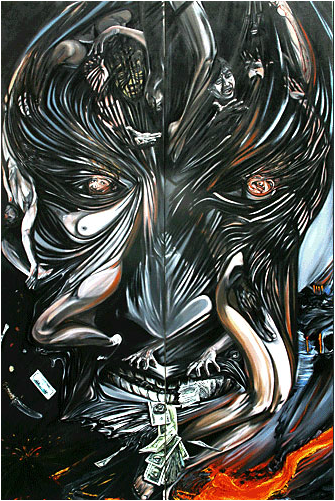Hades
The God of the underworld in Ancient mythology; brother of Zeus and husband of Persephone. That place void of Earthly seasons or the passage of time and yet shared by all mortals-The world of the dead, “No one goes to Hades with all his immense wealth” (Theognis,6th cen. B.C.).
Represented as an Israeli Zionist. In both Synoptic Gospels and the Gospel of John, the Jewish money changers were criticized for overseeing the exchange of Greek and Roman money to Jewish and Tyrian money. Today Jewish politics and international financial control are issues that greatly influence the entire world economy and the tenuous balance of peace and war between neighbouring cultures. However, the United States are the leading Imperialists in today's global village. Worldly spoils are therefore represented as the influence of American currency, as dollar bills spill out of Hades’ covetous mouth and are consumed in the lava of Hephaestus fire (from above). In his eyes, the fleeting euphoria of a father's lust, the dissection of the scorned wife, while Hades’ nose is the back of a withdrawn child, caught between the two, recoiling at the collective loss caused by infidelity and a broken family. By the very different issues explored in this piece the emphasis is not a didactic comment on a specific culture or politic, but rather is to raise often taboo—but widely discussed—topics, and to examine the necessary balance between self-preservation, greed and selfishness, both individually and privately (in the home) and socially (as a collective group, be it a village or an entire culture).
This sextych is the centerpiece of the whole collection, and is the last piece completed in 2009.
The artist wants us to contemplate our global interconnectivity, and to remember the exploited and underfed; the wealthy and the violent all find themselves being encompassed in death's cloak, be it "nature's decline" (Shakespeare- 12th Sonnet) or a self-induced world war.
Night / Seasonless and timeless Underworld
The God of the underworld in Ancient mythology; brother of Zeus and husband of Persephone. That place void of Earthly seasons or the passage of time and yet shared by all mortals-The world of the dead, “No one goes to Hades with all his immense wealth” (Theognis,6th cen. B.C.).
Represented as an Israeli Zionist. In both Synoptic Gospels and the Gospel of John, the Jewish money changers were criticized for overseeing the exchange of Greek and Roman money to Jewish and Tyrian money. Today Jewish politics and international financial control are issues that greatly influence the entire world economy and the tenuous balance of peace and war between neighbouring cultures. However, the United States are the leading Imperialists in today's global village. Worldly spoils are therefore represented as the influence of American currency, as dollar bills spill out of Hades’ covetous mouth and are consumed in the lava of Hephaestus fire (from above). In his eyes, the fleeting euphoria of a father's lust, the dissection of the scorned wife, while Hades’ nose is the back of a withdrawn child, caught between the two, recoiling at the collective loss caused by infidelity and a broken family. By the very different issues explored in this piece the emphasis is not a didactic comment on a specific culture or politic, but rather is to raise often taboo—but widely discussed—topics, and to examine the necessary balance between self-preservation, greed and selfishness, both individually and privately (in the home) and socially (as a collective group, be it a village or an entire culture).
This sextych is the centerpiece of the whole collection, and is the last piece completed in 2009.
The artist wants us to contemplate our global interconnectivity, and to remember the exploited and underfed; the wealthy and the violent all find themselves being encompassed in death's cloak, be it "nature's decline" (Shakespeare- 12th Sonnet) or a self-induced world war.
Night / Seasonless and timeless Underworld
© Copyright 2016 Jeffrey A’Hearn

